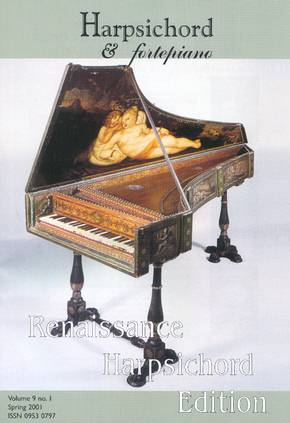| Home |
| SoundBoard |
| Current Issue |
| Talking Point |
| Index |
| Subscription |
| Discussion Forum |
Volume 9 no.1 (Spring 2001)
 RENAISSANCE
HARPSICHORD EDITION
RENAISSANCE
HARPSICHORD EDITION
"The latest Harpsichord & Fortepiano is the best yet."
(Early Music Review April 2001)
In this edition, ideas about what the 16th-century harpsichord sounded like are explored and overturned. Philip Pickett's commission of a 1531 Trasuntino copy, strung at low pitch, has proved to be a winner with all those who have heard it, both in solo recital and in performance with the New London Consort. While the softer, more lute-like tones of the instrument are a revelation to us today, they fit in very well with contemporary ideas about articulation, and this experiment cannot lightly be dismissed.
For a few days of English summer sunshine we were fortunate enough to spend time with maker Joel Katzman and the director of the New London Consort, Philip Pickett, viewing a variety of historical instruments in collections in and around London. Along the way we took the opportunity it quiz Katzman on his construction of the Trasuntino copy, and to press Pickett on his views about articulation in the Renaissance and how, therefore, the instrument should be played. Of key importance to both of them is Nicholas Mitchell's theory of a unified pitch, and we therefore open the debate with his outline of pitch practice during the Renaissance. Although the article might seem a little tough-going for those of us with only a dim grasp of pitch standards, it is well worth persevering with: in it the author tackles the all-too-frequently overlooked question of how instruments from different countries were played together, and why musicians were able to buy instruments from centres all over Europe. This leads on to Andrew Stewart's interview with Joel Katzman, in which we see how Mitchell's ideas about scaling and pitch are in tune with Katzman's own philosophy of instrument-making. Following are two articles related to our general topic: Paula Woods' fascinating account of the misunderstandings which the pitch system caused English buyers on the Continent, and Asako Hirabayashi's astute questioning of the relevance of the Bevin table for our realisation of Elizabethan keyboard ornaments. We finish with a shortened review section.
 |
 |
Cover photograph:
Harpsichord by Alessandro Trasuntino, Venice, 1531.Reproduced by permission
of the Royal College of Music, London (Museum of Instruments).
REVIEWS
Books
The Early Pianoforte by Stewart Pollens (Cambridge University Press)
The Pianoforte in the Classical Era by Michael Cole (Clarendon Press, Oxford)
Fortepianos and their Music: Germany, Austria and England, 1760-1800 by Katalin Komlós (Clarendon Press, Oxford)
Keyboard Instruments in Eighteenth-Century Vienna by Richard Maunder (Clarendon Press, Oxford)
Mozart's Piano Sonatas: Contexts, Sources, Styles by John Irving (Cambridge University Press)
Haydn Studies edited by W Dean Sutcliffe (Cambridge University Press)
Haydn's Keyboard Music: Studies in Performance Practice by Bernard Harrison (Clarendon Press, Oxford)
The Keyboard Sonatas of Joseph Haydn by László Somfai (The University of Chicago Press)
Discs
The Dublin Virginal Manuscript Joseph Payne, organ & harpsichord (DICD 920592)
Farewell Delighte: Fortune My Foe (English Virginal Music to commemorate the 350th Anniversary of the Execution of King Charles I in 1649) David Leigh, harpsichord (Acanthus 94010)
